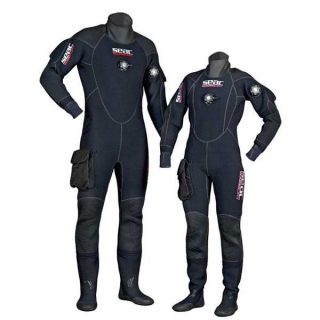
That saying "every teacher has his own book" when it comes to choosing the best diving suit makes more sense than ever. And each diver prefers to opt for one model or another for diving depending on how cold you are, how comfortable you are, if it is more or less fashionable...
But above all, we must keep in mind that a diving suit must serve to minimize as much as possible the dangers that can be suffered while practicing our favorite water sport, whether possible scratches, loss of body heat or stings from some marine species.
For those who are doubtful about what type of diving suit to buy, here we show you the main characteristics of each one so that you can analyze which one is best for you for the type of dives you usually do.
2. Semi-dry diving suit
3. Wet diving suit
1. Dry diving suit

- The main characteristic of these suits is that they guarantee total watertightness. Your body will not be in contact with water at any time.
- They are generally made of neoprene, which allows you to wear little clothing and keep your body heat intact.
- Perfect for diving in very low temperature waters or very long dives.
- Being totally hermetic "requires" that it has to have valves in its design to insert air inside.
- Its construction makes the suit less tight to the body than other models.
- Using a dry suit for diving requires more experience than with any other type, especially due to the changes in buoyancy experienced by the air inside and therefore, the understanding and expansion of this at the moment of immersion or vice versa.
- To know how to use it correctly it is recommended to take a specific course that teaches you how to maintain it correctly. Even so, its resistance is much lower than other models.
- Its price is a lot high.
2. Semi-dry diving suit

- This diving suit is preferred by the vast majority as it is the most versatile of all. It can be used in winter but also in summer and no prior knowledge is required to use it.
- Recommended for diving at temperatures between 10-25 ºC.
- Perfect for recreational diving due to thermal comfort and waterproofing.
- They are made of neoprene.
- The seals they have on the ankles, wrists and neck mean that no (or almost no) water passes through inside them, which saves a lot of energy during practice.
- They maintain heat throughout the dive.
- You have to have the help of another person to close the zipper of the suit, since they are sealed to make it more watertight in addition to being located on the back to prevent it from getting tangled with other accessories.
3. Wet diving suit

- Wet diving suit models are designed for diving at high temperatures or in summer.
- Body heat with this type of suit is maintained thanks to the thermal barrier that is created between the skin and the outside thanks to the thickness of the neoprene trapping water between the suit and the body.
- The neoprene in these suits are made up of large bubbles and uniforms that insulate you.
- The thickness in this type of neoprene suits is essential. They range from 1 mm to 9, depending on the temperature of the water in which you are going to submerge.
- A wetsuit needs to fit your body, but not tight, so take your time and try a few on, letting the expert advise you.
- There are three types of wetsuits: shorties, short-sleeved and knee-length; full body that covers your extremities; and the two-piece ones, which you can use as double insulation or separately.

If you are going to buy a technical suit for diving it is understood that it is because you are not a sporadic amateur to this practice and you know where you want to do your scuba dives with all the guarantees. But even so, it is always advisable to ask for advice from diving shops and schools to tell you which are the best results for each type of practice.
Here you will find the best diving professionals that exist in our country. Offers on dives, schools and all kinds of diving courses for those who are not satisfied with just any adventure. Go get yours! We know that in this case, it is in the sea...












